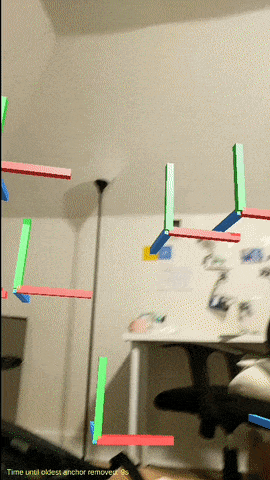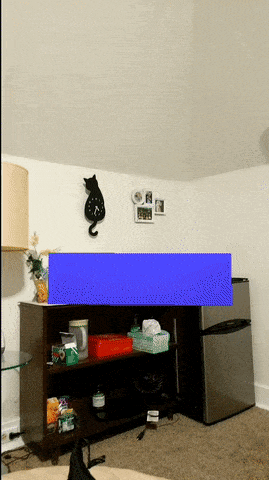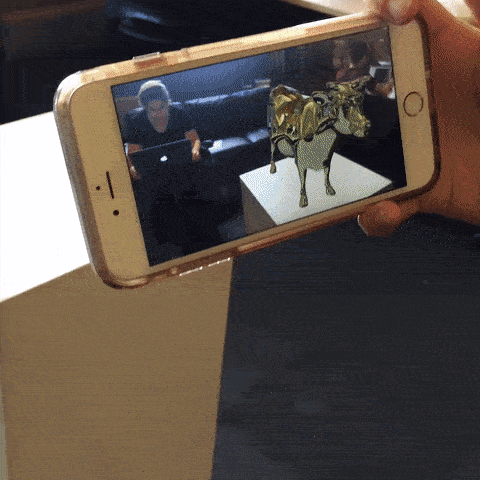This 2.5-week project has the following three deadlines:
- A “sketch” is due on Monday, November 30, in a blog post Categorized 10-ARSketch. It is suggested that you create your sketches with both the JustALine AR doodling app, as well as with pencil-and-paper.
- Ideally, any technical hurdles should be resolved by Wednesday, December 2. There is no deliverable for this deadline per se, but you should be prepared to give a brief statement about the status of your technical triumph in class.
- The project and its video documentation are due on Wednesday, December 9, presented in a blog post (categorized 10-ARSculpture) as described below. There will be an in-class critique that uses these blog posts.
A Brief Video About A Site-Specific Virtual Sculpture
The site is a place where a piece should be but isn’t. —Robert Smithson
View this post on Instagram
In this assignment, you are asked to create a brief video about an augmented reality. You will:
-
- place and view a virtual thing of your choice,
- at a scale of your choice,
- in a specific location of your choice,
- with a programmatic behavior of your choice,
- and then document that thing in a brief video, with appropriate storytelling.
Justify your decisions and document your process. It is assumed that your AR project will run on your Google Pixel 4 phone. Use this project as an opportunity to learn how to do something new in Unity. Note that the storytelling in your video is equally important as the software you make!
- Your thing (object, sculpture, phenomenon, etc.) may be appropriated, recycled, or constructed. For example, you could download a readymade 3D model from the Internet, or you could model something in Blender, Rhino or Maya. You might conceive of your object as a “sculpture”, “monument”, “installation”, “decoration”, etc. or as something else entirely (an “anomaly”, “natural formation”, cryptozoological phenomenon, etc.). For some ideas, check out Atlas Obscura’s archive of more than 400 Unusual Monuments.
- Your location may be public, private, generic, etc. For example, your site could be a prominent and unique location (the CMU Fence, Phipps Botanical Gardens), or it could be a generic-seeming place (a supermarket meat section), or it could be a very personal spot (your bedroom, or the palm of your hand).
- Your programmatic behavior should be some code you have written that makes the object do something. For example, it could spin (rotate) in place, or bob up and down, sinusoidally; it could emit a shower of particles (like a fountain); it could change size whenever the viewer gets close; it could swap out for a variant whenever the viewer looks away and looks back.
- To develop your project, see the template unity projects linked below.
 |
Note. What do we mean by a “programmatic behavior”? Well, consider the (very simple!) computational relationship between the dilation of the pupil and the openness of the user’s mouth in this AR face mask by Erik Winkowski.
Furthermore, consider how the quality of the artist’s performance (such as the way he inhales, the direction he faces, and the shape of his mouth) supports “storytelling” in this 3-second clip. He doesn’t just demonstrate a mathematical relationship; he performs as a surprised cyclops. |
Document your project in a (single) video. It is generally recommended (but not strictly required) that you combine screen-grabbed video (to show what someone is seeing in the phone), with over-the-shoulder video (to show the context in which the AR is observed). It could be helpful to include a soundtrack and/or captions. It is OK if your video is brief! If your concept can be effectively communicated in as little as 10-15 seconds, that’s great.
- Create a blog post, with the title nickname-ARSculpture.
- Give your blog post the Category, 10-ARSculpture.
- Write a very brief, one-sentence description of your project, suitable for a tweet. What is your project?
- Include a brief text about your project (~100-150 words). Discuss the relations you have established between object, environment, and viewer. Why did you decide to put this object in this place?
- Embed the video that presents your project.
- Also embed an animated GIF of your project, please.
- You are welcome to work alone, or (if you can do so safely) in pairs.
Unity Templates for Augmented Reality
Connie Ye’s ARCore Templates for Android
Connie Ye (BCSA ’21) developed a series of template projects to develop AR projects in Android (using ARCore): ARCore-Educational-Templates. It is strongly recommended that you use these templates to develop your project. Note, however, that they were developed in November 2019, using (now) slightly out-of-date versions of Unity and the ARCore SDK. For this reason be sure to follow the update instructions by Ho Chi Lau, below.
Update Instructions for Unity 2019 LTS + ARCore Template
Our TA, Ho Chi Lau, has written these important instructions for getting Unity 2019 LTS and ARCore Educational Template to work together.


